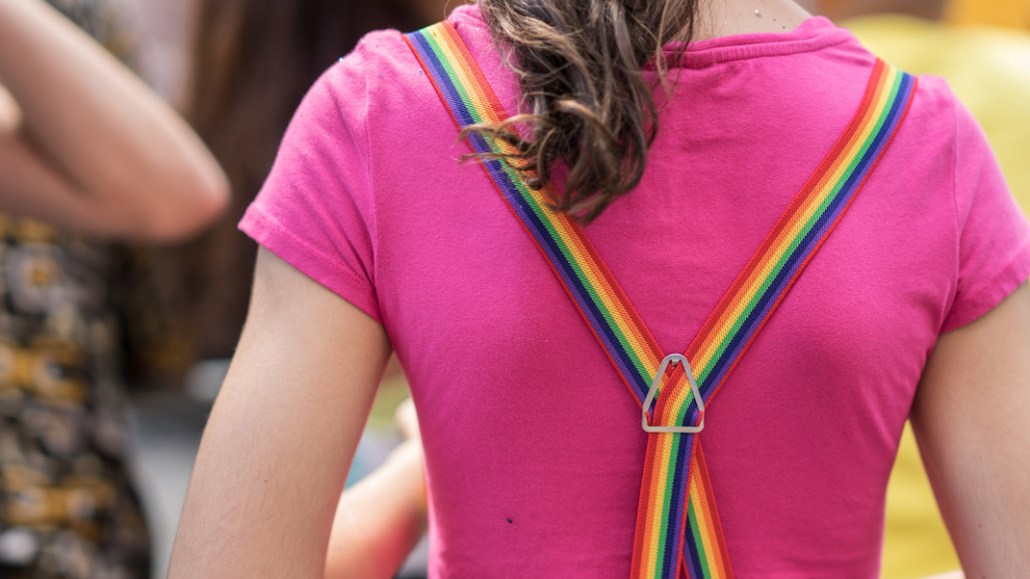Save 50% on a 3-month Digiday+ membership. Ends Dec 5.
‘Championing the people you don’t see enough’: Q.Digital relaunches LGBTQ+ pub Into for Gen Z, BIPOC audiences

Q.Digital, publisher of digital media brands like Queerty and Gay Cities, has relaunched Into, the publication launched by the gay dating app Grindr which shuttered it in January 2019. The new owner says Into will fill a gap in the LGBTQ+ media market by speaking to both the Gen Z and BIPOC community.
Q.Digital acquired Into in December 2020 for an undisclosed amount. As part of the deal, the publisher picked up Into’s website domain and social media accounts. The company has spent the last few months deciding on the new direction of the publication, hiring staff and redesigning the site. It officially relaunches May 3, with FX show “Pose” as the launch sponsor.
Grindr had previously shut down the digital publication after a 17-month run, following controversial comments made by Grindr president Scott Chen about same-sex marriage, which led to a few employees stepping down in protest.
Into will now have a different focus, said Scott Gatz, founder and CEO of the 13-year-old Q.Digital. Previously, Into had a more general news and pop culture focus, but that is a space already covered by Q.Digital’s LGBTQ Nation brand. Into will serve as a lifestyle and culture publication, with personal essays and stories on the community, “championing the people you don’t see enough of in the media,” Gatz said. It will specifically target Gen Z and BIPOC audiences “on the gender spectrum,” according to Gatz.
An LGBTQ+ brand relaunching with a focus on a young audience “could be a differentiator for [a media company] in this space,” said Steven Bloom, managing director, print and publisher relationships at Omnicom Media Group. “They found an area in the market where another brand can fit in nicely.”
There is also business opportunity in this audience. The global annual spending power of the LGBTQ consumer segment is estimated at $3.9 trillion, according to LGBT Capital. And one in six Gen Z adults identifies as LGBTQ, according to a Gallup survey published in February. Additionally, 42% of LGBTQ adults identify as people of color, slightly more than the diversity of the overall U.S. adult population, according to The Williams Institute at UCLA. BIPOC markets have $3.9 trillion buying power, according to a report from the University of Georgia.)
“RFPs this season have been very focused on this community and advertisers want to reach folks who are younger,” Gatz said. “We are seeing much bigger brands come into play.” Q.Digital has worked with brands like Lexus, Toyota, Nissan, Target, Mastercard and Reebok.
Ad position: web_incontent_pos1
While Bloom does believe more advertisers are coming into the LGBTQ+ market, “big brands have been supporting this space for a long time. It’s not just endemic advertisers.” Bloom, who said he could not discuss specific advertisers’ strategies, added that there is “a nice selection of advertisers” working with publishers targeting the LGBTQ+ audience.
Most of Q.Digital revenue is from advertising, with brands in automotive, entertainment, finance, pharmaceutical, retail and travel categories. Gatz said the company does not disclose revenue numbers, but that the “vast majority” of revenue is driven by direct ad sales, as well as display ads, sponsorships, custom branded content and video series and social programs. Q.Digital has “never taken outside investment,” according to Gatz, who said the company is “bootstrapped,” and that revenue funds new initiatives, including the acquisition and relaunch of Into.
Into’s editor-in-chief is Henry Giardina, a nonbinary trans man. The new website design and Into’s branding was created by Brinley Ford, a nonbinary trans person. Giardina’s team is made up of about 30 freelancers, “to ensure we uplift diverse perspectives and voices,” Gatz said.
The lead story on the Into homepage on the afternoon of Apr. 30 was a profile of Dominique Morgan, a Black trans woman who is a community activist, musician and executive director of Black and Pink, an LGBTQ+-focused prison abolition organization. Another story focuses on the LGBTQ+ Muslim community around the world, and another on the love story of two bisexual girls who found each other via TikTok. Gatz said upcoming stories will look at the Marvel Cinematic Universe’s first out-gay superhero, and the new, inclusive face of Dungeons & Dragons.
In an emailed statement, Adam K. Pawlus, executive director of NLGJA: The Association of LGBTQ Journalists, said LGBTQ media is “vital, not just for the news industry, but for LGBTQ communities and individuals.” While many news outlets “are facing mounting challenges,” LGBTQ journalists are “innovating” to ensure “our stories get told,” Pawlus added.
Ad position: web_incontent_pos2
Q.Digital — which includes Gay Cities (“gay TripAdvisor,” according to Gatz), Queerty (“gay BuzzFeed”), and news site LGBTQ Nation — has 16 full-time staffers.
According to Comscore data, Queerty.com attracts roughly 1 million unique visitors a month, GayCities.com draws in around 100,000, and LGBTQNation.com had nearly 900,000 in March 2021. Q.Digital’s marketing and social team will support Into and the publication will be Q.Digital’s first brand to have a presence on TikTok.
More in Media

What publishers are wishing for this holiday season: End AI scraping and determine AI-powered audience value
Publishers want a fair, structured, regulated AI environment and they also want to define what the next decade of audience metrics looks like.

Digiday+ Research Subscription Index 2025: Subscription strategies from Bloomberg, The New York Times, Vox and others
Digiday’s third annual Subscription Index examines and measures publishers’ subscription strategies to identify common approaches and key tactics among Bloomberg, The New York Times, Vox and others.

From lawsuits to lobbying: How publishers are fighting AI
We may be closing out 2025, but publishers aren’t retreating from the battle of AI search — some are escalating it, and they expect the fight to stretch deep into 2026.
Ad position: web_bfu




